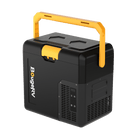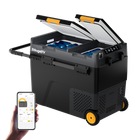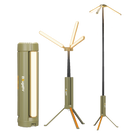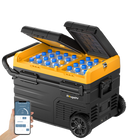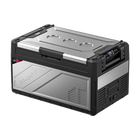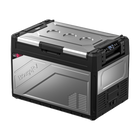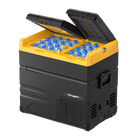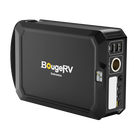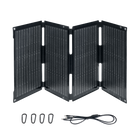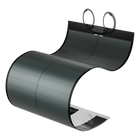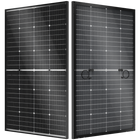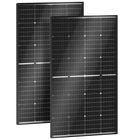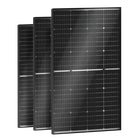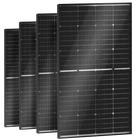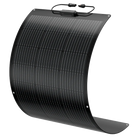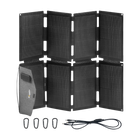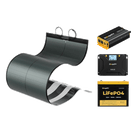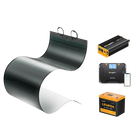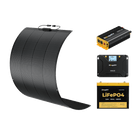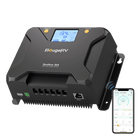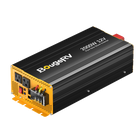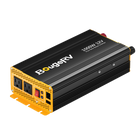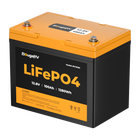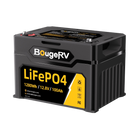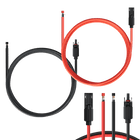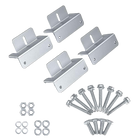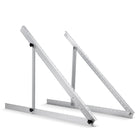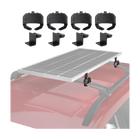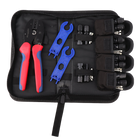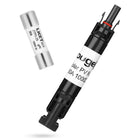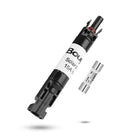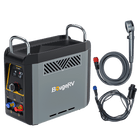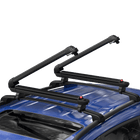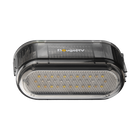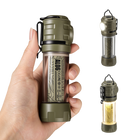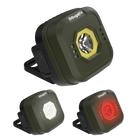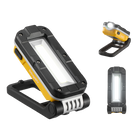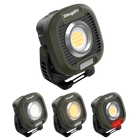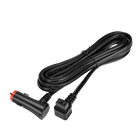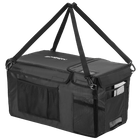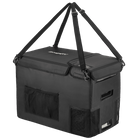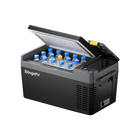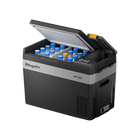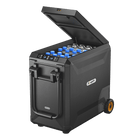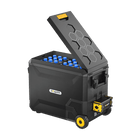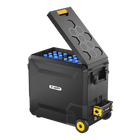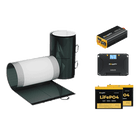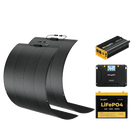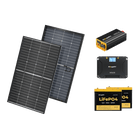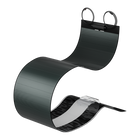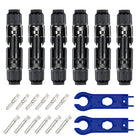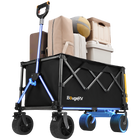How to Reduce Solar Panel Voltage?


You've got solar panels—pretty cool, right? Clean, green energy zipping around, cutting down electric bills. But sometimes, they get a little overzealous and pump out more voltage than you bargained for. That's not so chill for your battery, inverter, or devices that are hitched to them.
No worries, though! We're diving into the ins and outs of voltage, why keeping it on the down-low matters, how you can easily reduce solar panel voltage using an MPPT Charge Controller or a Step-Down Converter, and more. Read on to discover now!
Understanding Solar Panel Voltage
First off, let's break down what we mean by "solar panel voltage."
Solar panel voltage refers to the electrical potential difference generated by a panel. The voltage of solar panels varies, with residential units typically producing about 18 to 30 volts under open-circuit conditions (the maximum voltage a solar panel produces when not connected to any electrical circuit). Commercial panels might have higher voltages.
Solar panel voltage too high is a common problem that can occur when you have a mismatch between your solar panel and your battery or application. Any voltage significantly above your battery bank's or inverter's input rating may be considered too high.

Why Should You Reduce Your Solar Panel Voltage?
When integrating solar panels into a system, it's critical to ensure the voltage output aligns with the rating of the connected battery. Over-voltage can harm the battery and damage other electrical components connected to the system. For instance, for a 20-volt panel with a 12-volt battery, you must reduce the voltage to prevent overcharging and avoid damaging the battery or shortening its lifespan.
Moreover, electrical devices and charge controllers typically operate within specific voltage ranges. Matching the solar panel voltage to these ranges ensures that your system works efficiently and safely.
Efficient power transfer from the solar panels to the batteries or inverter is another area where voltage regulation plays a pivotal role. Voltage regulation minimizes the power losses due to mismatched voltages.
In addition, preventing over-voltage is essential for safety. High voltage scenarios can result in electrical overheating, which may lead to fires or equipment failures.
Lastly, consistently providing the correct voltage helps prevent stress on electrical components, thus extending the life of these components.
Factors to Think About Before Lowering Voltage
Before attempting to lower your solar panel's voltage, keep in mind the following:
-
Compare the voltage, current, and power specifications of your devices against the output of your solar panel, ensuring compatibility with your system and wiring.
-
Determine how much you want to reduce your solar panel’s voltage, being aware of the trade-offs between voltage and current, as reducing the voltage will increase the current and vice versa.

Ways to Check Your Solar Panel’s Voltage
You can check your solar panel’s voltage by using a multimeter or a voltmeter. Using a multimeter is the most straightforward way to check the voltage and ascertain if the voltage output aligns with your system's needs. A voltmeter is a device that can only measure voltage.
To measure the voltage of your solar panel, here are some steps to follow:
-
Set your multimeter or voltmeter to DC voltage mode and select an appropriate range (e.g., 20V or 200V).
-
Disconnect your solar panel from any load or battery and ensure it is exposed to direct sunlight.
-
Connect the positive (+) probe of your meter to the positive (+) terminal of your solar panel and the negative (-) probe to the negative (-) terminal.
-
Read the voltage value displayed on your meter. This is the open-circuit voltage ( the maximum voltage a solar panel produces when not connected to any electrical circuit) of your solar panel, which is the maximum voltage it can produce when there is no load connected.
-
To measure the voltage under load, connect your solar panel to a load or battery and repeat steps 3 and 4. This is the operating voltage (VMP) of your solar panel, which is the voltage at which it delivers the maximum power.
Then, compare the value with the information on the label at the back of your solar panel. If they are similar or very close, it indicates that your panel is performing correctly.
How Can You Reduce Solar Panel Voltage? 4 Methods
You can reduce the solar panels' voltage by selecting the right components and configuring the system setup to the desired voltage level. Here, we compile several methods to help.
A. Wiring Configurations: Series vs. Parallel
If your solar panel voltage is too high for your battery bank or charge controller, switching from a series to a parallel configuration will lower the voltage but increase the current, and remember to use thicker wire to handle the increased amperage safely. Here are the steps to make the switch:
-
Disconnect your solar panels from any connected energy storage or conversion devices.
-
Unlink the positive end of one panel from the negative terminal of the next, which is how they're connected in series.
-
Reconnect the panels by joining the positive terminals together and then connecting the negative terminals, establishing a parallel connection.
-
Use appropriate connectors like MC4 Y-branch connectors to ensure a secure and weather-proof connection.
-
Once in parallel, check the total voltage output to confirm it matches your system's requirements.
-
Reconnect your panels to the battery bank or charge controller, observing proper safety protocol and power ratings to prevent any electrical issues.
B. Use Mppt Charge Controller to Reduce Solar Panel Voltage

A charge controller manages the voltage and current flowing from your solar panels to a battery or directly to a device. There are two main types of charge controllers: PWM and MPPT charge controllers.
An MPPT charge controller can convert excess voltage into additional current and optimize both voltage and current by tracking the solar panel's Maximum Power Point (MPP). Although they are more complex and expensive, MPPT charge controllers are ideal for larger systems or those with significant voltage differences. They can improve system efficiency by up to 30% and handle variable environmental conditions better than PWM controllers.
To reduce your solar panel’s voltage with an MPPT charge controller, here are some steps to follow:

-
Choose an MPPT charge controller with a sufficient input voltage range, output voltage range, current rating, and power rating.
-
Connect your solar panel to the input terminals of your MPPT charge controller using appropriate wires and connectors.
-
Connect your battery or application to the output terminals of your MPPT charge controller using appropriate wires and connectors.
-
Configure the settings of your MPPT charge controller according to your system’s requirements. You can use a display screen, buttons, switches, or software to adjust the parameters such as output voltage, charging mode, load control, etc.
-
Monitor the performance of your system using indicators such as LED lights, meters, or software. You can check the input voltage, output voltage, input current, output current, power output, etc.
Using an MPPT solar charge controller is especially beneficial for your RV journey in sunny locations, where high voltage levels on particularly bright days could pose a risk to your RV's electrical system.
At BougeRV, we provide quality MPPT solar charge controllers of different amperages for 12V/24V systems, you can check them out at BougeRV.com.
C. Use Solar Panel Step-Down Converter
A step-down converter, also known as a buck converter, can convert a higher DC voltage to a lower DC voltage using a switching regulator. It reduces the voltage by storing energy in an inductor or capacitor and then releasing it at a lower voltage level that matches your system's needs. The step-down converter is less expensive than an MPPT charge controller but not as efficient. To use a buck converter to reduce solar panel voltage:
-
Select a buck converter that is properly rated for your solar panel’s output and has an adequate conversion efficiency rating.
-
Connect the panel's positive and negative wires to the converter’s input.
-
Set the converter to output the voltage required by your device or battery.
-
Wire the load to the converter’s output.
-
Double-check all connections for safety and accuracy.
-
Always follow best practices such as using a converter with protective features, securing connections, and providing adequate cooling.
D. Reconfiguring the Panel via the Junction Box
Adjusting the wiring within a solar panel's junction box is another way to change the overall voltage and current of the array. To begin, turn off the system to ensure safety. Open the junction box to access the electrical connections, including bypass diodes and terminals that link the solar cells.
Inside the junction box, you can rewire the cells from series to parallel, or the reverse, based on your needs. A parallel configuration will increase current while keeping voltage constant, suitable for systems needing more amperage.
Once you've changed the wiring, close the junction box to protect against environmental elements. Then reactivate the system and observe its performance to confirm the modifications are successful and meet the required specifications for the inverter or other components.
Note: Reconfiguring solar panels through a junction box is intricate and poses a risk of damaging the panels if not done correctly. This task should be handled by a certified electrician or skilled technician.
Conclusion

Effectively managing solar panel voltage is crucial for ensuring the longevity and safety of your system. Whether employing an MPPT charge controller, utilizing a step-down converter, or adjusting your setup's wiring configuration to reduce voltage, correctly following the outlined guidelines mentioned above can enhance performance and protect your equipment.
Take charge of your solar output today to guarantee that your clean energy solution remains as reliable as it is environmentally friendly. Looking for more solar insights? Keep an eye on BougeRV.com for quality solar products and expert advice and tips!
FAQs
1. Can You Change the Voltage of a Solar Panel?
Yes, you can adjust the voltage of a solar panel to better suit your system's needs. This can be done by altering the panel's wiring configuration, using an MPPT charge controller or a step-down converter, or reconfiguring the connection points within the solar panel's junction box.
2. What Is the Solar System Voltage?
The solar system voltage refers to the electrical potential difference generated by solar panels, typically ranging from 12 to 48 volts for home installations, while large-scale commercial or utility solar systems can operate at much higher voltages, often in the kilovolt(kV) range.
3. How to Reduce the Voc of Solar Panels?
To decrease the open-circuit voltage (Voc) of solar panels efficiently, you should use a solar charge controller or an MPPT regulator. These devices step down the voltage to a level suitable for your battery system, ensuring safe and effective charging.
4. How Do You Limit the Output of Solar Panels?
Limiting the output of solar panels can be done by installing a charge controller, which regulates the flow of voltage and current to the battery or other loads.
Alternatively, power optimizers can be attached to each solar panel, allowing for individual control over their output to prevent it from surpassing desired levels.
5. What Voltage Is Too High for Solar Panel?
The voltage considered too high for a solar panel depends on its rated maximum power point voltage and the voltage tolerance of connected components like charge controllers and inverters. Exceeding 20% above the rated voltage could damage these components or reduce system performance.
For a 12V system, voltages exceeding 15-18 volts are generally too high and can be harmful. But, always consult your solar panel's spec sheet and component limits.







